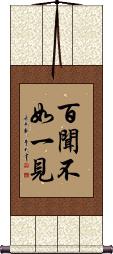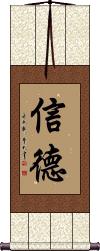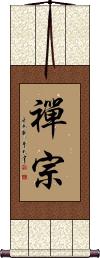Many custom options...
And formats...

Believing in Chinese / Japanese...
Buy a Believing calligraphy wall scroll here!
Personalize your custom “Believing” project by clicking the button next to your favorite “Believing” title below...
Seeing is Believing
百聞は一見に如かず is the Japanese version of an ancient Chinese proverb that means “Seeing once is better than hearing one hundred times.”
It is the rough equivalent of “seeing is believing,” “one eye-witness is better than many hearsays,” or “a picture is worth a thousand words.”
Sometimes it's simply more prudent to verify with your own eyes.
Note: Because this selection contains some special Japanese Hiragana characters, it should be written by a Japanese calligrapher.
See Also: Hearing a Hundred Times is Not as Good as Seeing Once
Seeing is Believing
百聞不如一見 is a proverb that means “Better to see something once rather than hear about it one hundred times” or “Telling me about something 100 times is not as good as seeing it once.”
In English, we have the similar proverb of “Seeing is believing” but this has a bit of the “A picture paints a thousand words” meaning too.
Sometimes it's simply more prudent to verify with your own eyes.
Faith
Hearing a Hundred Times is Not as Good as Seeing Once
百聞不如一見 is a Chinese proverb that means “Seeing once is better than hearing one hundred times” which is similar to the idea of “Seeing is believing.”
You can also get the idea, “Seeing for oneself is better than hearing from many others.”
If you break it down directly, you get “100 hears/listens (is) not as-good (as) one sight.”
Trust No One / Trust No Man
誰も信じるな is as close as you can get to the phrase “trust no man” in Japanese, though no gender is specified.
The first two characters mean everyone or anyone but change to “no one” with the addition of a negative verb.
The third through fifth characters express the idea of believing in, placing trust in, confiding in, or having faith in.
The last character makes the sentence negative (without the last character, this would mean “trust everyone,” with that last character, it's “trust no one”).
Note: Because this selection contains some special Japanese Hiragana characters, it should be written by a Japanese calligrapher.
Zen Buddhism
禪宗 is one way to title “Zen Buddhism.” Because the original pronunciation of Zen in Chinese is Chan, you'll also see this expressed as Chan Buddhism.
From the Buddhist Dictionary:
The Chan, meditative or intuitional, sect is usually said to have been established in China by Bodhidharma, the twenty-eighth patriarch, who brought the tradition of the Buddha-mind from India. This sect, believing in direct enlightenment, disregarded ritual and sūtras and depended upon the inner light and personal influence for the propagation of its tenets, founding itself on the esoteric tradition supposed to have been imparted to Kāśyapa by the Buddha, who indicated his meaning by plucking a flower without further explanation. Kāśyapa smiled in apprehension and is supposed to have passed on this mystic method to the patriarchs. The successor of Bodhidharma was 慧可 Huike, and he was succeeded by 僧璨 Sengcan, 道信 Daoxin, 弘忍 Hongren, 慧能 Huineng, and 神秀 Shenxiu, the sect dividing under the two latter into the southern and northern schools: the southern school became prominent, producing 南嶽 Nanyue and 靑原 Qingyuan, the former succeeded by 馬祖 Mazu, the latter by 石頭 Shitou. From Mazu's school arose the five later schools.
Not the results for Believing that you were looking for?
Below are some entries from our dictionary that may match your Believing search...
| Characters If shown, 2nd row is Simp. Chinese |
Pronunciation Romanization |
Simple Dictionary Definition |
信德 see styles |
xìn dé xin4 de2 hsin te shintoku |
More info & calligraphy: Faith |
信心 see styles |
xìn xīn xin4 xin1 hsin hsin shinjin しんじん |
More info & calligraphy: Confidence / Faithful Heart(noun, transitive verb) faith; belief; piety; devotion; godliness A believing mind, which receives without doubting.; Great or firm faith in, or surrender to Buddha, especially to Amitabha. |
禪宗 禅宗 see styles |
chán zōng chan2 zong1 ch`an tsung chan tsung Zenshū |
More info & calligraphy: Zen BuddhismThe Chan, meditative or intuitional, sect usually said to have been established in China by Bodhidharma, v. 達, the twenty-eighth patriarch, who brought the tradition of the Buddha-mind from India. Cf. 楞 13 Laṅkāvatāra sūtra. This sect, believing in direct enlightenment, disregarded ritual and sūtras and depended upon the inner light and personal influence for the propagation of its tenets, founding itself on the esoteric tradition supposed to have been imparted to Kāśyapa by the Buddha, who indicated his meaning by plucking a flower without further explanation. Kāśyapa smiled in apprehension and is supposed to have passed on this mystic method to the patriarchs. The successor of Bodhidharma was 慧可 Huike, and he was succeeded by 僧璨 Sengcan; 道信 Daoxin; 弘忍 Hongren; 慧能 Huineng, and 神秀 Shenxiu, the sect dividing under the two latter into the southern and northern schools: the southern school became prominent, producing 南嶽 Nanyue and 靑原 Qingyuan, the former succeeded by 馬祖 Mazu, the latter by 石頭 Shitou. From Mazu's school arose the five later schools, v. 禪門. |
百聞不如一見 百闻不如一见 see styles |
bǎi wén bù rú yī jiàn bai3 wen2 bu4 ru2 yi1 jian4 pai wen pu ju i chien |
More info & calligraphy: Seeing is Believing |
百聞は一見に如かず see styles |
hyakubunhaikkennishikazu ひゃくぶんはいっけんにしかず |
More info & calligraphy: Seeing is Believing |
住地 see styles |
zhù dì zhu4 di4 chu ti jūji |
living area; residential area Dwelling-place; abiding place in the Truth, i.e. the acquirement by faith of a self believing in the dharma and producing its fruits. |
信樂 信乐 see styles |
xìn lè xin4 le4 hsin le shigaraki しがらき |
(personal name) Shigaraki To believe and rejoice in the dharma; the joy of believing. |
信海 see styles |
xìn hǎi xin4 hai3 hsin hai shinkai しんかい |
(given name) Shinkai The ocean of faith: the true virtue of the believing hear is vast and boundless as the ocean. |
信行 see styles |
xìn xíng xin4 xing2 hsin hsing nobuyuki のぶゆき |
(surname, given name) Nobuyuki Believing action; faith and practice. Action resulting from faith in another's teaching, in contrast with 法行 action resulting from direct apprehension of the doctrine; the former is found among the 鈍根, i.e. those of inferior ability, the latter among the 利根, i.e. the mentally acute. |
南無 南无 see styles |
nā mó na1 mo2 na mo namu なむ |
Buddhist salutation or expression of faith (loanword from Sanskrit); Taiwan pr. [na2 mo2] (conj,int) {Buddh} amen; hail; (surname) Namu namaḥ; Pali: namo; to submit oneself to, from to bend, bow to, make obeisance, pay homage to; an expression of submission to command, complete commitment, reverence, devotion, trust for salvation, etc. Also written 南牟; 南謨; 南忙; 那謨 (or 那模 or 那麻); 納莫 (or 納慕); 娜母; 曩莫 (or 曩謨); 捺麻(or捺謨), etc. It is used constantly in liturgy, incantations, etc., especially as in namaḥ Amitābha, which is the formula of faith of the Pure-land sect, representing the believing heart of all beings and Amitābha's power and will to save; repeated in the hour of death it opens the entrance to the Pure Land. |
憑準 凭准 see styles |
píng zhǔn ping2 zhun3 p`ing chun ping chun |
evidence (that one can rely on); grounds (for believing something) |
行信 see styles |
xíng xìn xing2 xin4 hsing hsin yukinobu ゆきのぶ |
(p,s,g) Yukinobu Act and faith, doing and believing, acting out one's belief. |
不信重 see styles |
bù xìn zhòng bu4 xin4 zhong4 pu hsin chung fu shinjū |
not believing in |
増上慢 see styles |
zoujouman / zojoman ぞうじょうまん |
(noun or adjectival noun) (1) overconfidence; someone who is overconfident; (2) {Buddh} wrongly believing to have attained enlightenment |
法供養 法供养 see styles |
fǎ gōng yǎng fa3 gong1 yang3 fa kung yang hō kuyō |
dharmapūjā. Serving the Dharma, i. e. believing, explaining, keeping, obeying it, cultivating the spiritual nature, protecting and assisting Buddhism. Also, offerings of or to the Dharma. |
信心不二 see styles |
xìn xīn bù èr xin4 xin1 bu4 er4 hsin hsin pu erh shin shin funi |
unity of the believing and the believed |
半信半疑 see styles |
bàn xìn bàn yí ban4 xin4 ban4 yi2 pan hsin pan i hanshinhangi はんしんはんぎ |
(idiom) half believing, half doubting; not quite convinced; skeptical (noun - becomes adjective with の) (yoji) half in doubt; half-convinced; dubious; incredulous |
善男信女 see styles |
shàn nán xìn nǚ shan4 nan2 xin4 nu:3 shan nan hsin nü zennan shinnyo |
lay practitioners of Buddhism Good men and believing women. |
服水論師 服水论师 see styles |
fú shuǐ lùn shī fu2 shui3 lun4 shi1 fu shui lun shih bukusui ronji |
The sect of non-Buddhist philosophers who considered water the beginning and end of all things. |
眼見為實 眼见为实 see styles |
yǎn jiàn wéi shí yan3 jian4 wei2 shi2 yen chien wei shih |
seeing is believing |
言い包める see styles |
iikurumeru / ikurumeru いいくるめる |
(transitive verb) to deceive somebody into believing (e.g. that black is white); to cajole; to talk into; to explain away (e.g. unpleasant evidence); to argue away; to wheedle |
言いくるめる see styles |
iikurumeru / ikurumeru いいくるめる |
(transitive verb) to deceive somebody into believing (e.g. that black is white); to cajole; to talk into; to explain away (e.g. unpleasant evidence); to argue away; to wheedle |
百聞は一見にしかず see styles |
hyakubunhaikkennishikazu ひゃくぶんはいっけんにしかず |
(expression) seeing is believing; one eye-witness is better than many hearsays; a picture is worth a thousand words |
耳聽為虛,眼見為實 耳听为虚,眼见为实 |
ěr tīng wéi xū , yǎn jiàn wéi shí er3 ting1 wei2 xu1 , yan3 jian4 wei2 shi2 erh t`ing wei hsü , yen chien wei shih erh ting wei hsü , yen chien wei shih |
(idiom) you cannot always trust what you hear, but seeing is believing |
聞くと見るとは大違い see styles |
kikutomirutohaoochigai きくとみるとはおおちがい |
(expression) (proverb) don't believe everything you hear; seeing is believing; to have heard of is not to have seen |
Variations: |
marunomi まるのみ |
(noun, transitive verb) (1) swallowing whole; swallowing without chewing; (noun, transitive verb) (2) swallowing (a story); believing unquestioningly; accepting blindly; accepting without fully understanding; memorizing without understanding; (noun, transitive verb) (3) accepting (a proposal, demand, etc.) unconditionally; accepting as-is |
Variations: |
marunomi まるのみ |
(noun, transitive verb) (1) swallowing whole; swallowing without chewing; (noun, transitive verb) (2) swallowing (a story); believing unquestioningly; accepting blindly; accepting without fully understanding; memorizing without understanding; (noun, transitive verb) (3) accepting (a proposal, demand, etc.) unconditionally; accepting as-is |
Variations: |
hyakubunhaikkennishikazu ひゃくぶんはいっけんにしかず |
(expression) (proverb) seeing is believing; one eye-witness is better than many hearsays; a picture is worth a thousand words |
Variations: |
marunomi まるのみ |
(noun, transitive verb) (1) swallowing whole; swallowing without chewing; (noun, transitive verb) (2) swallowing (a story); believing unquestioningly; accepting blindly; accepting without fully understanding; memorizing without understanding; (noun, transitive verb) (3) accepting (a proposal, demand, etc.) unconditionally; accepting as-is |
The following table may be helpful for those studying Chinese or Japanese...
| Title | Characters | Romaji (Romanized Japanese) | Various forms of Romanized Chinese | |
| Seeing is Believing | 百聞は一見に如かず | hyakubun wa ikken ni shikazu hyakubunwaikkennishikazu hyakubun wa iken ni shikazu | ||
| Seeing is Believing | 百聞不如一見 百闻不如一见 | bǎi wén bù rú yí jiàn bai3 wen2 bu4 ru2 yi2 jian4 bai wen bu ru yi jian baiwenburuyijian | pai wen pu ju i chien paiwenpujuichien |
|
| Faith | 信德 | shin toku / shintoku | xìn dé / xin4 de2 / xin de / xinde | hsin te / hsinte |
| Hearing a Hundred Times is Not as Good as Seeing Once | 百聞不如一見 百闻不如一见 | bǎi wén bù rú yī jiàn bai3 wen2 bu4 ru2 yi1 jian4 bai wen bu ru yi jian baiwenburuyijian | pai wen pu ju i chien paiwenpujuichien |
|
| Trust No One Trust No Man | 誰も信じるな | dare mo shin ji ru na daremoshinjiruna | ||
| Zen Buddhism | 禪宗 禅宗 | zen shuu / zenshuu / zen shu | chán zōng chan2 zong1 chan zong chanzong | ch`an tsung chantsung chan tsung |
| In some entries above you will see that characters have different versions above and below a line. In these cases, the characters above the line are Traditional Chinese, while the ones below are Simplified Chinese. | ||||
Successful Chinese Character and Japanese Kanji calligraphy searches within the last few hours...








